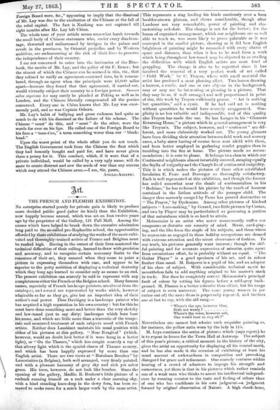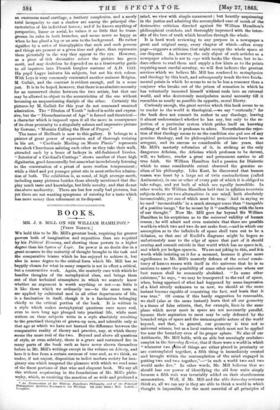3rt
THE FRENCH AND FLEMISH EXHIBITION.
No enterprise started purely for private gain is likely to produce more decided public good (after its kind) than the Exhibition, now happily become annual, which was set on foot twelve years ago by the proprietor of the Gallery, 121 Pall Mall. Among the causes which have helped to break down the excessive admiration long paid to the so-called pre-Raphaelite school, the opportunities afforded by these exhibitions of studying the works of the more culti- vated and thoroughly-trained artists of France and Belgiinn must be ranked high. Having in the outset of their lives mastered the technical difficulties of their calling, learned to draw with precision and accuracy, and to recognize certain necessary limits to the resources of their art, they succeed when they come to paint a picture in expressing themselves with ease, and appear to be superior to the petty ambition of displaying a technical dexterity which they long ago learned to consider only as means to an end. The present exhibition can scarcely be said to represent with any completeness either the French or the Belgian school. Many famous names, especially of French landscape painters, are absent from the catalogae, an 1 several are represented by works which, however admirable as far as they go, give but an imperfect idea of their author's real power. Thus Daubigny is a landscape painter who has acquired a high reputation in his own country : but for this he must have done something more and better than the very sketchy and low-toned (not to say dirty) landscapes which here bear his name, and which are little more than a travestie of the tempe- rate and measured treatment of such subjects usual with French artists. Neither does Lambiaet maintain his usual position with either of his pictures at this gallery, " Near %nivel " (which, however, world no doubt look better if it were hu ,.0; in a better light), or " On the Thames," which has caught scarcely a ray of that silvery light which is the special charm of Thames scenery, and which has been happily expressed by more than one English artist. There are two views at " Burnham Beeches " by Latnorinidre (a Belgian), both well arranged, very firmly painted, and with a pleasant harmony of grey sky and rich yet sober green. His trees, however, do not look like beeches. Since the opening of the gallery, Madlle. R. Bonheues little picture of a roebuck sunning himself on a rock under a clear morning sky, with a hind standing knee-deep in the dewy fern, has been re- moved to make room for a much larger work by the same artist.
This represents a stag leading his hinds cautiously over a bare boulder-strewn plateau, and shows considerable, though after Landseer not very remarkable, power of painting and cha- racterizing red-deer. The change is not for the better; for the lesson of organized management, which our neighbours are so well able to teach us, was more like'y to prove palatable as it was conveyed in the smaller picture, showing as it did how English brightness of painting might be reconciled with every charm of space and distance, than when it has to be read from a work which being throughout low-toned may be objected to as evading the difficulties with which English artists are most fond of
grappling. The change is also to be regretted since it has involved the removal of a very perfect work of art called " Field Work," by C. Troyon, where with small material the artist has produced a most pleasing effect. Two horses drawing a harrow, a rustic, and one or two objects in the background, may or may not be interesting or pleasing in a picture. That they may be so, if well arranged and well proportioned in point of size, this work by 'Troyon sufficiently proves. " Art is nothing but quantities," said a cynic. If he had said art is nothing without quantities he would have scarcely exaggerated. Sim- plicity is no less valuable and indispensable, and of this quality also Troyon has made due use. So has Laugee in his " Gleaners Returning Home," a picture which in general arrangement is very like Troyon's. The subject, however, and " sentiment" are dif- ferent, and more elaborately worked out. The young gleauera have been dividing their attention between field work and nursery cares, a baby sister having of course been sent afield with them, and been better employed in gathering scarlet poppies than in tumbling into the fire at home. The picture needs no recom- mendation; it is sure to please. It belongs to a class in which our Continental neighbours almost invariably succeed, escaping equally the Scylla of vulgarity and the Charybdis of sentimental insipidity. This it is which makes the pictures of those other established favoUrites E. Frere and Duverger so thoroughly satisfactory. Each is well represented at this exhibition, and though the former has sailed somewhat near the shoals of sentimentalism in his " Bedtime," he has redeemed his picture by the touch of humour contained in the listless attitude of the younger child. The danger thus narrowly escaped by Frere has proved destructive to "'The Prayer," by Dyckmans. Among other pictures of kindred subjects " Lace-making," by Gerard, two little pictures by Cagan, and two by Player may be particularized as possessing a portion of that naturalness which is so hard to attain.
Meissonnier is an artist who never unnecessarily ruffles our composure or disturbs our serenity of mind. Music, card-play- ing, and the like form the staple of his subjects, and those whom he represents as engaged in these holiday occupations are dressed with extreme attention and the nicest observance of fashion. To say truth, his pictures generally want interest ; though for skil- ful painting and for accurate expression of minutiae, quite apart from ostentatious effort, he is probably without an equal. " The . Guitar Player" is a good specimen of his art, and in colour fresher than usual. M. Ruiperez is a pupil of his, and an adopter of his class of subject. With considerable technical merit he nevertheless fails to add anything original to his master's stock in trade. Nor does he completely correct 111eissonnier's principal fault of colour by setting his figures before a cold-grey back- ground. M. Masan is a better colourist than either, but his range of subject is even narrower. The s one young woman in (or rather out of) the same dress is perpetually repeated, and inclines . one at last to say, with the old song,— " Where's the eye, however blue,
Doth not weary ? Where's the voice, however soft, One would hear so very oft?"
Nevertheless one cannot but admire such exquisite painting as, for instance, the yellow satin worn by the lady in 113.
M. Leys continues the series of pictures which (says report) he is to repeat in fresco for the Town Hall at Antwerp. The subject of this year's picture, a critical moment in the history of the city, gives the artist an opportunity for displaying all his wonted merit, and lie has also made it the occasion of exhibiting at least his usual amount of awkwardness in composition and provoking disregard for grace and refinement. One scarcely ventures within hearing of a crowd of admirers to impugn his strength and earnestness, yet there is that in his pictures which rather reminds one of a weak man who thinks to assert his intellectual independ- ence by running counter to the taste and feeling of others than of one who has confidence in his own judgment—a judgment formed by original observation of Nature. A high cheek-bone,
an enormous nasal cartilage, a leathery complexion, and a nearly total incapacity to cast a shadow are among the principal cha- racteristics of his individual hero ; and if he knows anything of perspective, linear or aerial, he values it so little that he trans- gresses its rules in both branches, and seems never so happy as when he has glued a leg or an arm to the background. He rather signifies by a series of hieroglyphics that such and such persons and things are present at a given time and place, than represents them pictorially in the way they appear to the eye. However, as a piece of rich decorative colour the picture has great merit, and may doubtless be depended on as a trustworthy guide to all inquirers into Flemish burgher costume of A.D. 1542. His pupil Lagye imitates his subjects, but not his rich colour. With Leys is very commonly contrasted another eminent Belgian, M. Gallait, and the contrast is evident enough, and in a sense just. It is to be hoped, however, that there is no absolute necessity for an unreserved choice between the two artiste, but that one may be allowed to object to the eccentricities of the one without becoming an unquestioning disciple of the other. Certainly the pictures by M. Gallait for this year do not command unmixed admiration. The " Illusion of Youth" indeed is noble and expres- sive, but the " Disenchantment of Age " is forced and theatrical- s character which is imposed upon it all the more in consequence of its close proximity to a singularly solemn and impressive picture by Gerome, "Muezzin Calling the Hour of Prayer."
The name of Heilbuth is new to this gallery. It belongs to a painter of great power of expression and of thorough training in his art. "Cardinals Meeting on Monte Pincio " represents two sleek Churchmen saluting each other as they take their walk, attended each by a brace of lackeys in old-fashioned liveries. " Interior of a Cardinal's Carriage" shows 'another of those high dignitaries, good-humouredly but somewhat incredulously listening to the conversation of a priest of more restless temperament ; while a third and yet younger priest sits in most orthodox admira- tion of both. The exhibition is, as usual, of high average merit, including many pictures besides those already mentioned that dis- play much taste and knowledge, but little novelty, and that do not rise above mediocrity. There are but few really bad pictures, but yet there are not wanting symptoms of catering for a taste which has more money than refinement at its disposal. V.



































 Previous page
Previous page